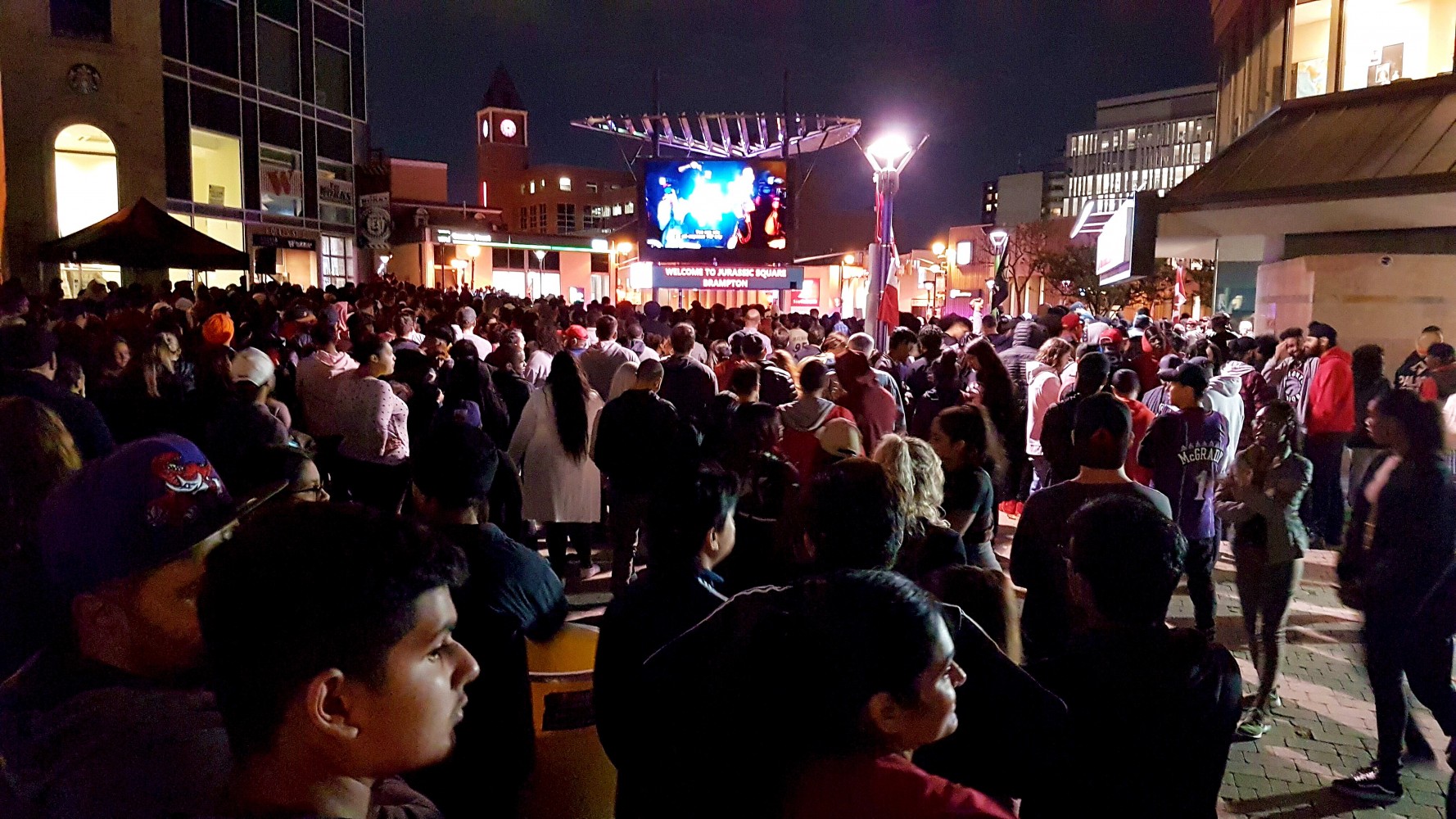
The gathering of people in a downtown square reminds us that we want to be together
They could have stayed at home and watched it on TV. They didn't need to fight traffic or circle for a half-hour to find a parking spot or stand uncomfortably for three hours as the drama unfolded before them on the big screen at Garden Square in downtown Brampton.
But 5,000 plus residents wanted to be there on Thursday night to witness the opening game of the NBA finals between the Toronto Raptors and the back-to-back champs, the Golden State Warriors.
It was the first international finals game in the history of the pro league.
For one night, in Brampton, there was a real sense of place.
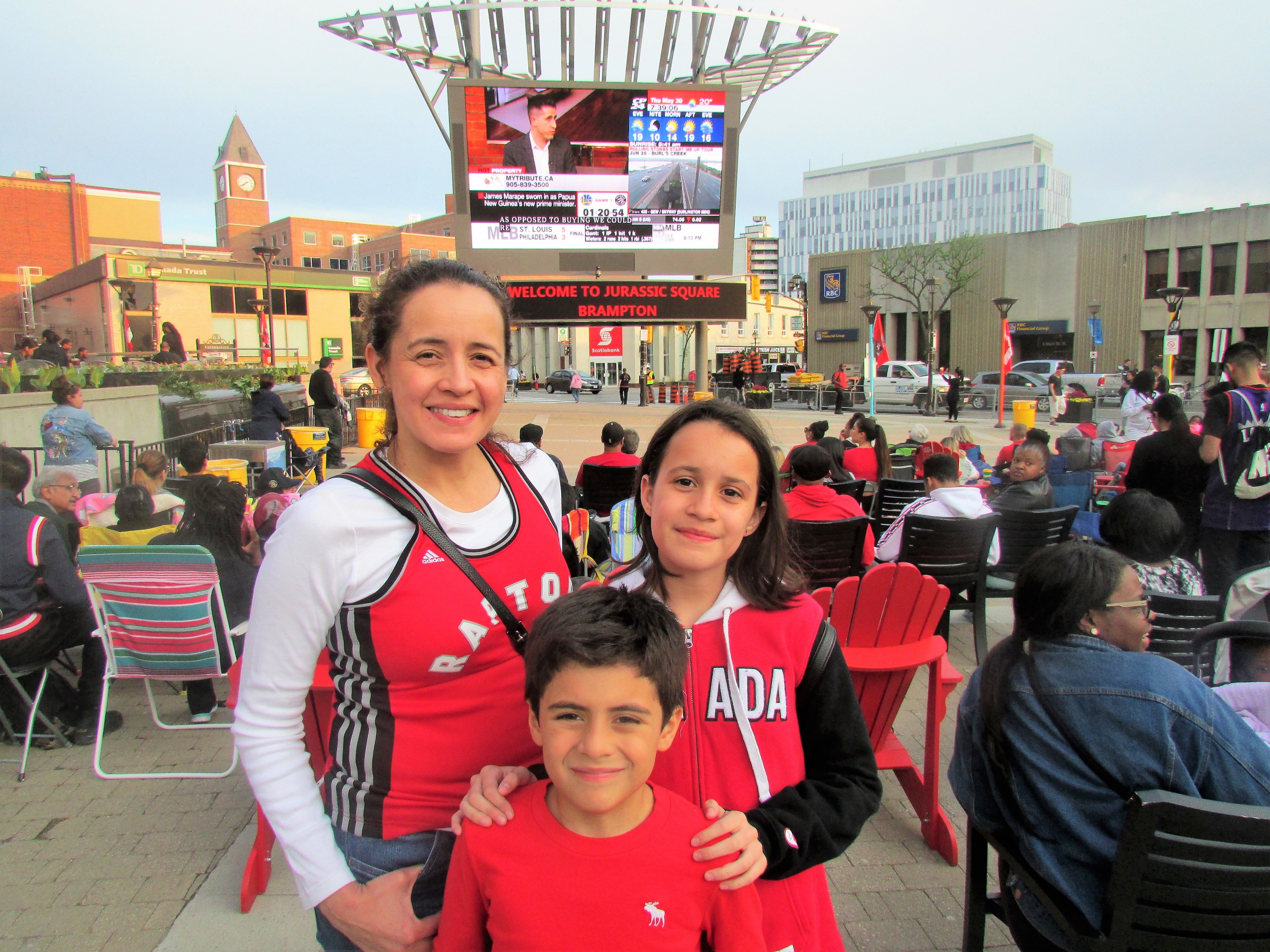
Odett Chacon arrived early for the game with her children, Lucas (front) and Sara
These fans were part of a growing tide of supporters who have spilled over the borders of Toronto and swept through cities and towns right across Canada. The Raptors are Canada’s team now, and diehard basketball fans and those new to the sport, sensed that Game One – and this entire series – was a chance to share in a new commonality, and to feel unmitigated joy.
It’s something the often exhilarating world of sport hasn’t done in any real unifying way for this city for quite some time.
The Brampton Battalion OHL team had the worst attendance in the Ontario Hockey League for four years before the club left for North Bay ahead of the 2013-14 season.
After barely paying its bills the Brampton Excelsiors lacrosse club, with almost 150 years in the city, was sold last year to a Detroit-area businessman who has kept the historic group here. The ECHL’s Brampton Beast hockey team, despite a controversial $1.5 million funding package from City Hall in 2016, continues to lose money and can’t even draw 3,000 fans. By comparison, the OHL’s London Knights packed about 9,000 fans for each game this season.
But do the Raps, and basketball, now offer a chance for Brampton to be part of an unfolding narrative – a piece of sports and even cultural history?
Game One delivered, as the Raptors upended the six-time NBA titlists 118-109, sending a charge into the wild Brampton night.
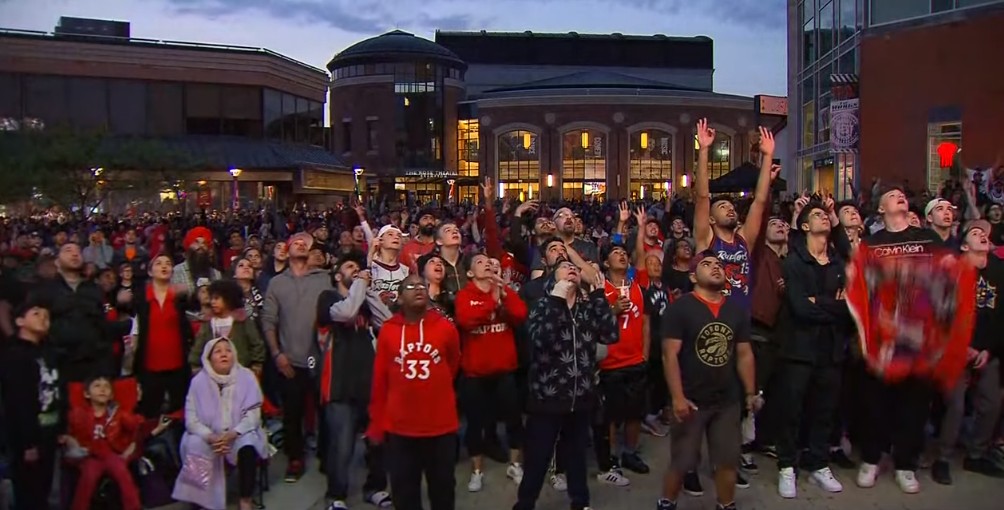
Before the game, floor seats at Scotiabank Centre in Toronto were being peddled online for upwards of $13,000, and about one billion viewers were watching worldwide on smart phones, laptops, tablets and TVs. But the most compelling action was taking place off-court, in the spill-over of thousands standing in nearby Jurassic Park, one of the most lively human compounds on the planet. Jurassic Park (Maple Leaf Square) has become THE place to be, a touchstone for the city – an energized, organic, bastion of fandom where the pent-up desires for a championship are played out every game, whether the Dinos are in town or on the road.
The scene at the west side of the arena, on the former Railway Lands, is like nothing the NBA has seen before. While the inside of Scotiabank Centre rocked with the breathless back-and-forth action, and the Raptor stars have become one-name icons to the fan base (Kyle, Pascal, and Kawhi), the freshest vibe is outside in the raw elements, where a youthful crowd of geared-up supporters surge in unison with every dribble, dunk and 3-point shot. They shout and wave banners and rise and fall with the team’s fortunes, and all this is played back in an endless loop on the TV highlights.
While pop-rapper Drake is the team’s most recognizable fan and supporter, and is often caught on camera because of his over-active court side shenanigans, even he recognizes that Jurassic Park is where the action is. For a recent game when the Raptors were playing in Milwaukee, he announced via Instagram that he would be there on stage, and urged others to join him. "Meet me in Jurassic Park at 8:30. Whole city should be out like the sun... history is upon us."
Yes, Toronto and the NBA are creating history off the dribble.
Because Jurassic Park has become a “thing,” why not multiply it out (say 20 times) to other cities and towns across the country, including Brampton?
After negotiations with Maple Leaf Sports and Entertainment, that’s what this city has done. That’s why Thursday night a great migration of moms and dads and kids in Raptor gear and cops on bikes and stragglers and curious bystanders and even the poor folk from the rooms that sit above the stores in the downtown core, all gathered as one. For this evening, they watched the on-screen action and screamed their bloody heads off and felt as if they were part of an ever-surging sea of supporters that ripped across the country.
For anyone who was there Thursday night, they’ll probably be back tomorrow (Sunday 8 pm) for Game Two, weather permitting. It was that much fun.
If the Raptors have created a new vibe, there is something even more profound going on in the belly of the beast. Yes, basketball, once a game consigned to fifth-sport status in this country and Brampton in particular, behind hockey, football, baseball, and soccer, is now on the ascendency. An inner-city game once played on the fringes, has become THE game – driven by its inexpensive start-up costs (far cheaper than hockey) and a changing demographic. Who knows what will be the answering echo to the Raptors most recent successes?
Welcome to Jurassic Square
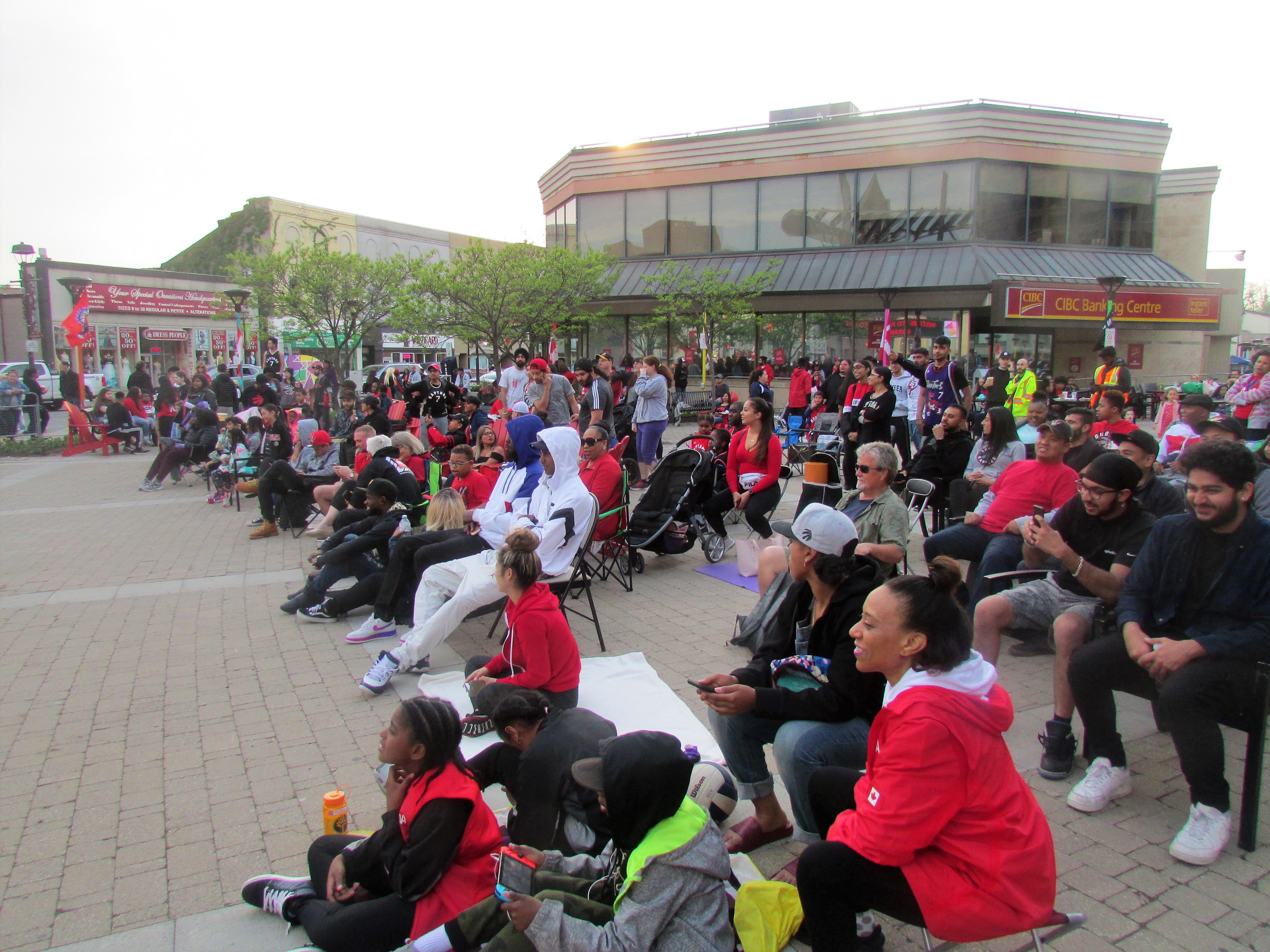
Let’s spin the clock back to about 7 p.m. on Thursday night at Jurassic Square in Brampton. The sun is descending slowly in the sky, and hides behind the clock tower at city hall, bathing the square in an eerie yellowish glow. The area is filling quickly as fans settle into hundreds of chairs provided by the City or into their own, replete with drinks and snacks. It’s reminiscent of the opening scene from American author Don DeLillo’s masterpiece, Underworld, as the crowd marches in for an afternoon playoff game between the Brooklyn Dodgers and the New York Giants. The mood is heightened because the winner gets to play in the 1951 World Series. “Longing on a large scale is what makes history,” wrote DeLillo, and the Giants crowd hoped and prayed for victory.
The opening pages pivot around a young inner-city Black kid named Cotter Martin who will eventually catch the winning home run ball hit off the bat of the Giants’ Bobby Thomson – “the shot heard ‘round the world.”
Delillo writes: “...this is just a kid with a local yearning but he is part of an assembling crowd, anonymous thousands off the buses and trains, people in narrow columns tramping over the swing bridge above the river, and even if they are not a migration or a revolution, some vast shaking of the soul, they bring with them the body heat of a great city… the stray tumble of their thoughts, going to a game.”
Ah, yes, going to a game. Not just a game, but THE game.
Now cue the first NBA finals series game outside of the United States. Brampton’s answer to Cotter Martin is Marlom Rohoman, 19, who is settling into a seat at Jurassic Square with his friends Nidaal Siddiqui and Sahill Meelu, all aged 19.
Rohoman is representative of today’s Brampton: young (Brampton has one of the lowest median ages in North America), a visible minority (his parents are immigrants from Guyana, and 74 percent of the city’s residents are visible minorities) and a graduate of one of the multitude of basketball programs that have sprung up here over the past decade.
He is now in his first year of a sports management program at Brock University and hopes one day to parlay those studies into a dream job with Basketball Canada.
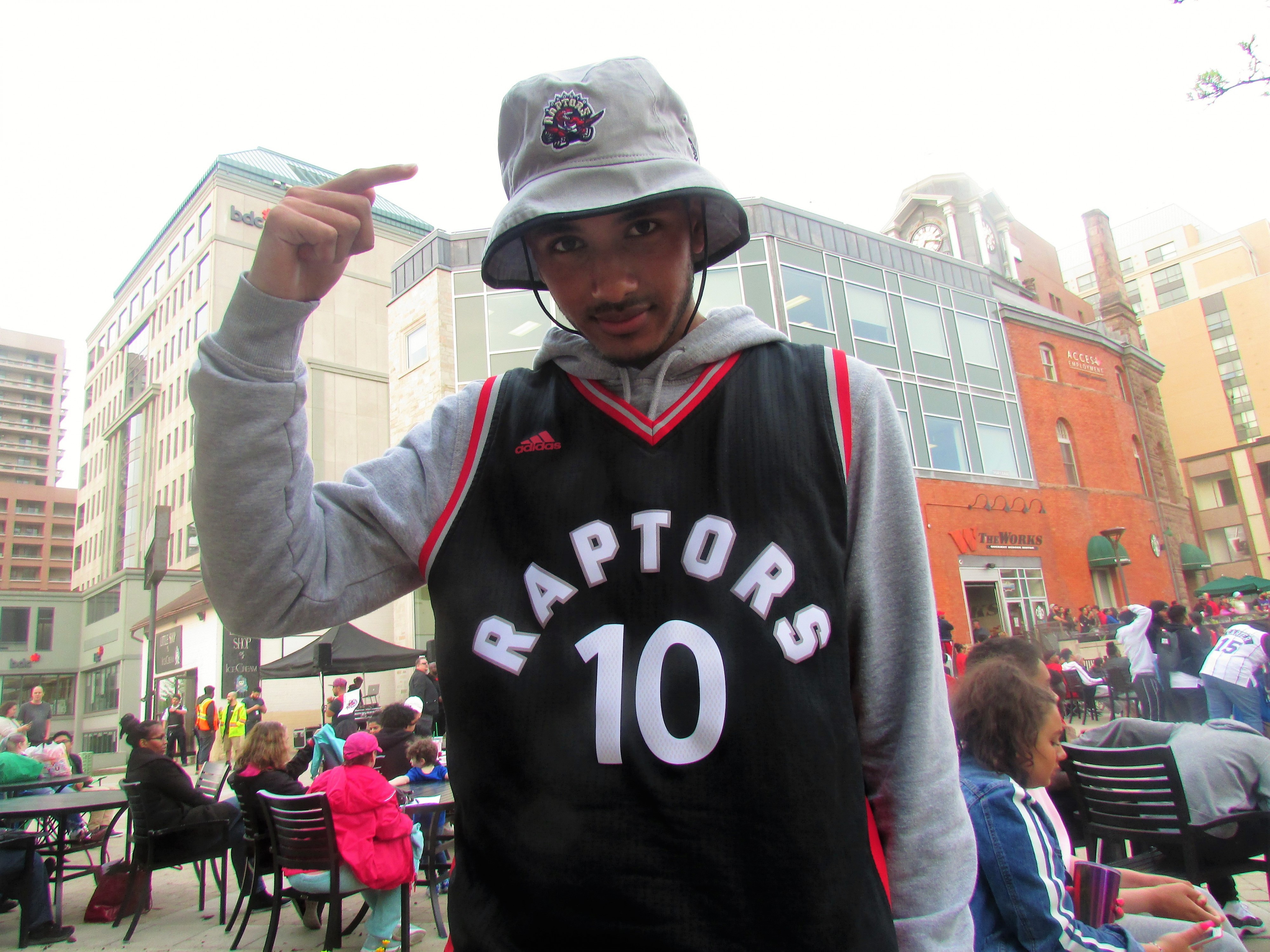
Brampton's Marlom Rohoman
Like his friends, he’s “gear-up” with Raptors’ stuff: a porkpie hat replete with team logo, and a jersey with the No. 10, worn by the beloved DeMar DeRozan, whose trade before the season for superstar Kawhi Leonard (who has elevated the team to transcendent heights) sent shockwaves across Raptor's Nation.
Rohoman’s mother wasn’t into sports, but his father was an outstanding cricket player. Their son didn’t grow up dribbling a basketball, but preferred soccer, baseball and track & field. Then, at age 9, he caught on TV the highlight reel of Kobe Bryant, the former L.A. Lakers star, torching the Toronto Raptors for 81 points. Rohoman wasn’t so much impressed by Bryant’s daring-do, but felt a pang of sorrow for the Raps, a team that up to this point in his life, he was not interested in. But he liked the speed and agility needed to play the game and after watching Kobe, he joined CIA Bounce, a program for kids age 9 to 19. It was a league started by Tyler Ennis’s father, the ex-Syracuse University star and NBA player. He also tried out for a team in Basketball Bros., another local organization, but didn’t make one of its travelling teams. He stayed on to perfect the fundamentals of the game. He practiced twice a week at St. Roch Secondary School and played games at the courts at the Brampton Soccer Centre. He was soon competing against teams in his age-group in Toronto, and as far away as Michigan. He was good, but not great, and didn’t make the varsity team at Brock. He’s recognized his true talents might lie in the management side of basketball.
But he has now been a fanatical Raptors’ fan since Kobe ate them for lunch.
His passion for the team has ebbed and flowed over the years while the players have been dubbed underachievers for much of their history – until this magical year. This spring it all came together in his basement as he watched the Raptors beat the Milwaukee Bucks and clinch the NBA’s Eastern Conference title, setting up the showdown with the dynastic Warriors.
Rohoman admits when the clock ticked down to zero, he jumped up and almost hit his head on the ceiling. The most memorable moment from that game was when "Kyle Lowry was at centre court and the Raptors had clinched the win and he had this huge smile on his face and he knew that the team had won. I was getting goosebumps. I still get goosebumps thinking about it.”
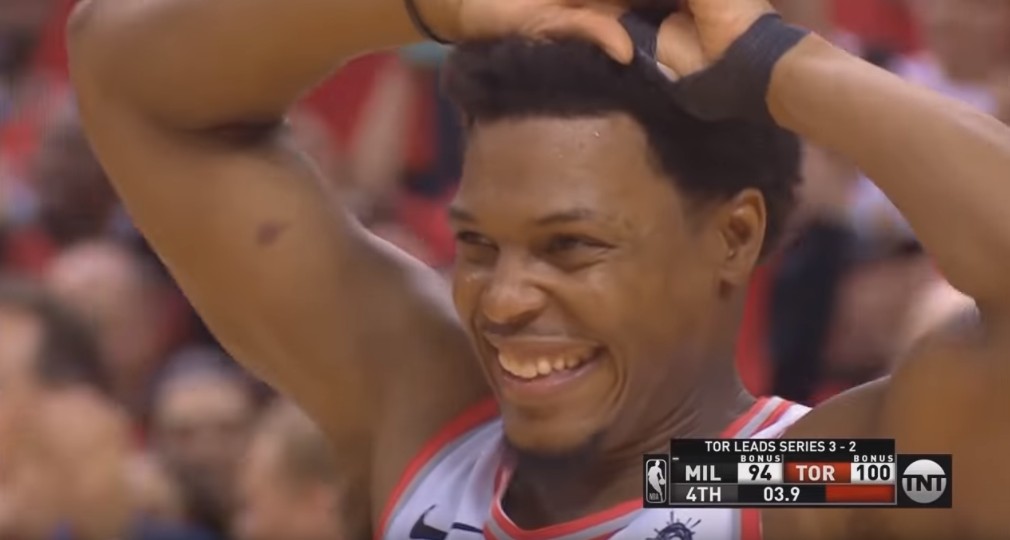
In the moments before Game One of the Raptors-Warriors series, he was noticeably jumpy, and eager to see the game start on the big screen. He said “the Raptors always failed us,” but was hopeful that this year was different. He said he was thrilled basketball was not a “secondary sport anymore,” and as he looked around at the gathering throng of supporters in the square, he said he was happy the city reached out to Maple Leaf Sports & Entertainment so local fans were able to gather here. He even sent the city a message urging them to get the Raps up on the big screen.
A lot has changed for the Fern Forest public school player, who did his high school playing at Harold Brathwaite Secondary where Anthony Bennett, a former No. 1 overall pick of the Cleveland Cavaliers is also an alumnus.
Rohoman said he initially learned the game when he bought a pint-sized basketball at Zellers and played on the street near his home in the Bramalea Road-Bovaird Drive area of the city. Yes, basketball has plenty of street cred in Brampton, although the growth of the game here is very much tied to school-based or organized programs that now fill the gyms.
Aspiring to help kids
One program targeted to help the underprivileged youth in the city learn the game is Aspire 4 Higher. It’s the brainchild of Brampton’s Abena Addo, a civil engineering grad from McGill and the University of Toronto who now works as a transportation engineer for Metrolinx.
It is a non-profit basketball camp that began in 2013 with an Ontario government grant and has grown six-fold with instructors from university programs and minor pro leagues. It has partnered with the Peel District School Board and is run in schools like Sandalwood Heights, St. Edmund Campion, St. Thomas Aquinas, Louise Arbour, Jean Augustine, and Sheridan College’s Davis Campus, among others. It has also teamed with Canadian Tire’s Jumpstart program. “Our mandate is that every child has the right to high quality sport instruction regardless of financial circumstances,” says its founder.
Aspire 4 Higher and Jumpstart are not just about getting kids active, but giving those from families in financial need a chance to try a new sport or to continue with a favourite one.
The community connections to basketball in this city run deep, from the Raptors 905 minor league team that plays in Mississauga and is linked to the City of Brampton through its annual summer camp for kids, to the YMCA youth programs and, of course, the Peel Police basketball team that has played numerous games against high school teams throughout Brampton over the years.
Nora Gorman of the GTA YMCA, says the success of the Raptors is only building on the sport's considerable popularity.
"Barriers to entry for playing basketball are very low so...that definitely helps with its popularity, as does the success of the Raptors, the national teams and the success of young Canadians who have played NCAA (the U.S. university athletics' system)," says the organization's vice president of marketing and communications. "We know that when the gymnasium is not used for a scheduled program, immediately youth start trickling in to play basketball…individually or in small groups…they self-organize in pickup games. Basketball is popular all over the world... (the GTA) is home to many newcomers – many of them come to the Y and find a 'community' playing basketball with people who share their love of the game."
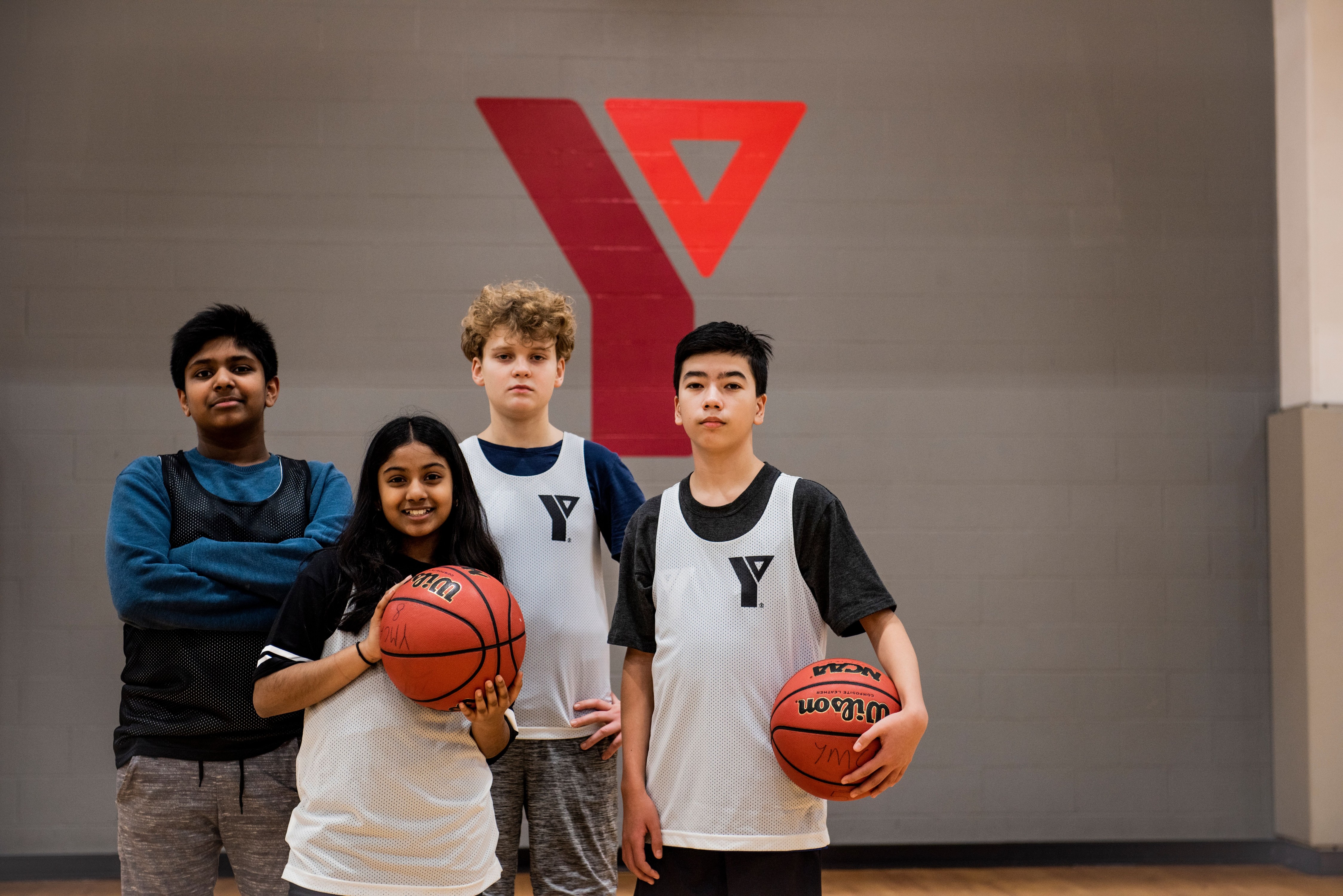
Peel Police’s Diversity Cup Basketball Tournament goes back more than a generation when it was held at the University of Toronto-Mississauga campus and involved diverse groups. The police were committed to promoting positive relations with varied ethnic/racial/religious and cultural communities in the region.
In 2015, Councillor Gurpreet Dhillon founded his “Drop-in Basketball’ program, which is a free youth initiative that aims to keep kids off the streets and out of gangs through sport.
In April of this year, a group of five-year-old boys from the program were caught on video giving out a lesson in friendship that went viral. The CBC News reported that the kids’ basketball team gathered for a huddle, and Shabaig Singh Dhillon (the councillor’s son) led a team hug that racked up more than one million views and almost 165,000 "likes" on Instagram because of the emotions this “sweet moment” stirred in viewers. The group hug even grabbed the attention of American sports broadcaster ESPN.
Participation numbers have been exploding even before the Raptors’ recent win streak. The CBC reported two years ago that for players aged three to 17, basketball ranked as the third most popular team sport in Canada, behind only soccer and hockey, with 354,000 participants, according to a 2014 Youth Sports Report. Most telling, the game led hockey among immigrant youth, and checked in second behind soccer. Of sports participants from ages 5 to 14, basketball went from a 13 per cent participation rate in 1998 to a 16 per cent in 2010, according to a sports participation report published by Canadian Heritage. The sport is in good shape because its popularity is being driven at two levels, top-down and bottom-up.
In Brampton, Bennett’s shocking choice as the No. 1 pick in the 2013 NBA draft was a shot of adrenalin to the game at the local level. Although he never panned as an NBA pro, his fellow Bramptonian, Tristan Thompson did. He attended St. Marguerite d’Youville Secondary School in Brampton for his freshman year before joining a prep school in New Jersey where he was recruited by the University of Texas. He was also picked by the Cavs (No. 4 in the 2011 draft). He helped them win an NBA title in 2016 over (you guessed it) the Warriors. He is an elite NBAer who has been part of a massive movement of Canadian-born players to the best league on the planet. An all-star Team Canada squad could include former Brampton star Tyler Ennis, as well as Kitchener’s Jamal Murray, Cory Joseph, Anthony Wiggins, Khem Birch, Trey Lyles, Shae Gilgeous-Alexander, Kelly Olynyk, Dwight Powell, Dillon Brooks and Nik Stauskas. The most telling take is that these players were not spawned on courts in the inner-cities, but in the suburbs. They learned in gyms and after-school programs like the ones that brought players like Rohoman into the game.
The growth in Canada will no doubt be hyper-charged by the current success of the Raptors, but trying to extrapolate out by how much is a guessing game. There’s little doubt school programs, youth leagues, and just pick-up games will now draft off the Raptors’ run for glory.
Greg Francis, coach of The University of Ontario Institute of Technology Ridgebacks in Oshawa, as well as the manager of men's high performance at Canada Basketball, the National Sports Organization for the game, has said in the past that “more youth are choosing basketball over hockey,” and Canada Basketball “has really focused on this youthful wave.”
The tremendous outpouring of support for the Raptors is playing out in real time in television ratings that are now threatening numbers driven by the Toronto Maple Leafs, a ratings juggernaut. A record 7.4 million Canadians tuned in to watch the Raptors take on the Warriors. The game captured an average audience of 3.3 million viewers, making it the most-watched NBA game ever in Canada. Those numbers didn’t include the 5,000 plus at Jurassic Square, or the 20,000 who showed up at Celebration Square in Mississauga, or the other hundreds of thousands that took in the game on big screens inside bars, house parties and outdoor gatherings right across the country. How many kids who are now watching and will chuck their hockey gear for a b-ball and sneakers is hard to estimate – but the fallout from the Raptors’ run could be significant for years to come.
The shrinking mainstream Canadian media, led by a comically homogenous group of white decision makers, can no longer use the tired line that “hockey obliterates the ratings” to justify its lagging coverage of basketball – social media and other technologies now reflect the actual reality unfolding across the country.
It’s clear that technology is bringing basketball to the masses, and Adam Silver, the forward-looking commissioner of the NBA pointed out before the start of the Raptors-Warriors series that in Africa, for example, it is now a hotbed for the game. Over 400 million people have access to the game through the apps on their smart phones. They have also been inspired by former greats like Hakeem Olajuwon, an NBA star from 1984 to 2002 with the Houston Rockets, and Dikembe Mutombo. The current crop of Raptors includes African-born players Serge Ibaka and Pascal Siakam, as well as the UK-born OG Anunoby (whose parents are Nigerian) and the club’s president, Masai Ujiri, also from Nigeria. Other massive markets like China have embraced the game, too, ever since Yao Ming played in the NBA. The league started playing pre-season games there in 2004.
Can hockey or baseball come close to matching this international appeal?
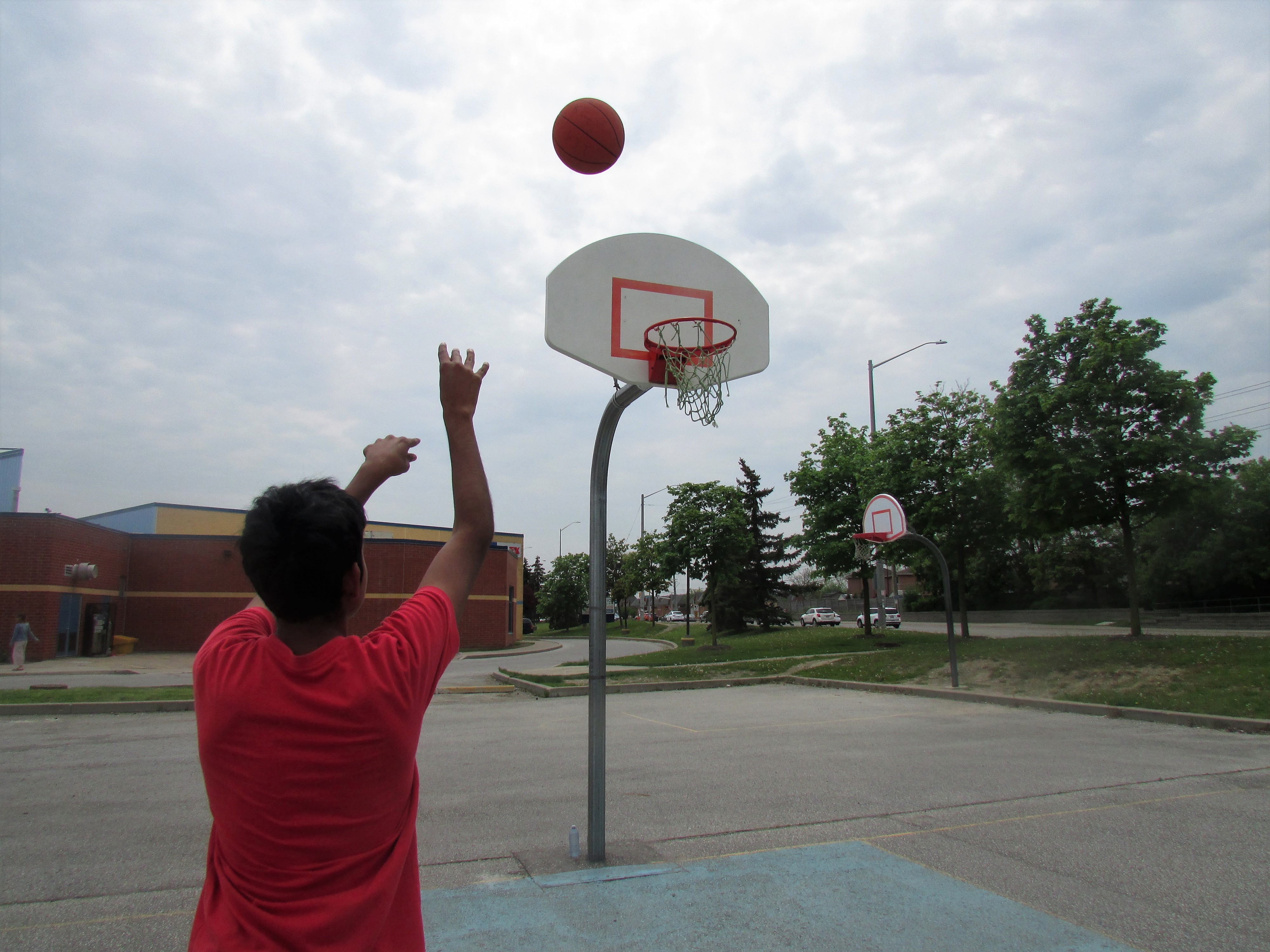
Is the game’s real draw the fact it is colour and culturally blind, inexpensive and simple to learn? After all, the only things needed are a ball, a hoop and a piece of blacktop.
Canada is now one of the most diverse countries in the world, and Brampton its most diverse city. It and basketball seem a perfect mix. On Thursday night, at Jurassic Square, it was the place to be for Marlom Rohoman and his friends, Nidaal Siddiqui, Sahill Meelu, and the over 5,000 other residents of the city.
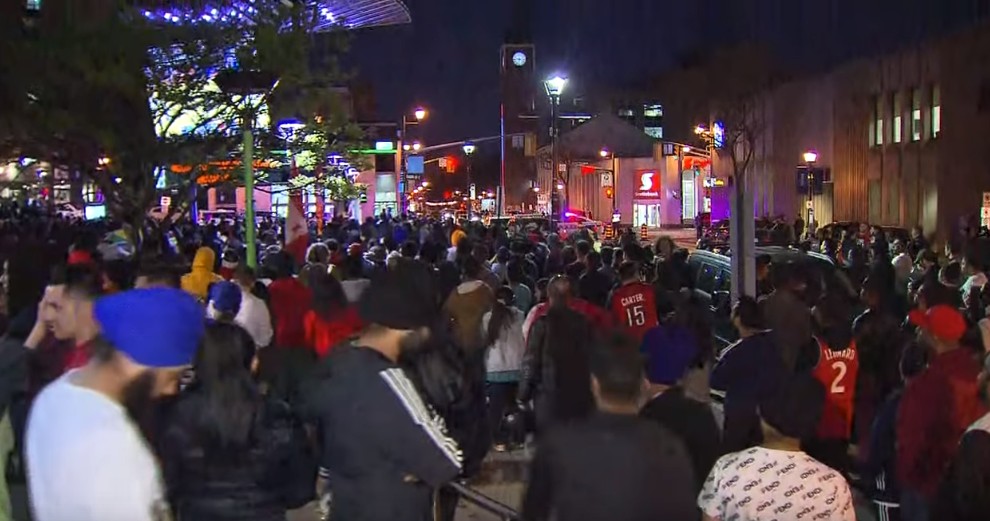
After the game, fans spilled out from the square and into the streets and either walked back to their homes or found their cars and packed away their chairs and kids and went home – still filled with the thrilling afterglow of the win.
Whether the Dinos grab a world championship and everyone goes completely ga-ga doesn’t really matter. What does is that over the past few weeks the game has been indelibly imprinted in the hearts and minds of a new legion of fans. Some of them will have been inspired to take up a game that was once the sixth-most popular in this city.
For two weeks at least, it is now No. 1.
And it’s bringing this city together.
Submit a correction about this story


